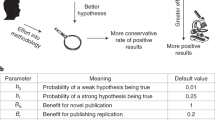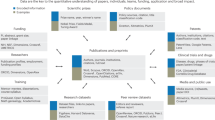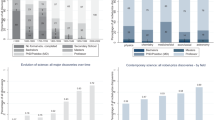Abstract
Scientific discovery is often perceived as associated with a single act of genius or a moment in time that changes one's thinking and scientific discourse. Most scientists know that this perception is almost always far from reality. Scientific discovery is reached through long, persistent effort from groups of people who are willing to take risks and are not afraid to fail. Equally important is that funders of scientific research appreciate the need for such persistent effort and do not look only for easily identifiable, short-term benefits. We may occasionally recognize historic ‘moments’, but these often occur because of the less famous but equally important advances that came before, often over decades of work.
This is a preview of subscription content, access via your institution
Access options
Access Nature and 54 other Nature Portfolio journals
Get Nature+, our best-value online-access subscription
$29.99 / 30 days
cancel any time
Subscribe to this journal
Receive 12 digital issues and online access to articles
$119.00 per year
only $9.92 per issue
Buy this article
- Purchase on Springer Link
- Instant access to full article PDF
Prices may be subject to local taxes which are calculated during checkout

GMUTLU
Similar content being viewed by others
References
Abbott, B. P. et al. Observation of gravitational waves from a binary black hole merger. Phys. Rev. Lett. 116, 061102 (2016).
Abbott, B. P. et al. GW150914: First results from the search for binary black hole coalescence with Advanced LIGO. Phys. Rev. D 93, 122003 (2016).
Abbott, B. P. et al. The basic physics of the binary black hole merger GW150914. Ann. Phys. 529, 1600209 (2017).
Casares, J. & Jonker, P. G. Mass measurements of stellar and intermediate-mass black holes. Space Sci. Rev. 183, 223–252 (2014).
Abbott, B. P. et al. Properties of the binary black hole merger GW150914. Phys. Rev. Lett. 116, 241102 (2016).
Pretorius, F. Evolution of binary black-hole spacetimes. Phys. Rev. Lett. 95, 121101 (2005).
Campanelli, M., Lousto, C. O., Marronetti, P. & Zlochower, Y. Accurate evolutions of orbiting black-hole binaries without excision. Phys. Rev. Lett. 96, 111101 (2006).
Baker, J. G., Centrella, J., Choi, D.-I., Koppitz, M. & van Meter, J. Gravitational-wave extraction from an inspiraling configuration of merging black holes. Phys. Rev. Lett. 96, 111102 (2006).
Abbott, B. P. et al. Tests of general relativity with GW150914. Phys. Rev. Lett. 116, 221101 (2016).
Abbott, B. P. et al. Astrophysical implications of the binary black-hole merger GW150914. Astrophys. J. Lett. 818, L22 (2016).
Abadie, J. et al. Search for gravitational waves from low mass compact binary coalescence in LIGO's sixth science run and Virgo's science runs 2 and 3. Phys. Rev. D 85, 082002 (2012).
Aasi, J. et al. Search for gravitational waves from binary black hole inspiral, merger, and ringdown in LIGO–Virgo data from 2009–2010. Phys. Rev. D 87, 022002 (2013).
Aasi, J. et al. Search for gravitational radiation from intermediate mass black hole binaries in data from the second LIGO–Virgo joint science run. Phys. Rev. D 89, 122003 (2014).
Abbott, B. P. et al. GW150914: The advanced LIGO detectors in the era of first discoveries. Phys. Rev. Lett. 116, 131103 (2016).
Abbott, B. P. et al. The rate of binary black hole mergers inferred from advanced LIGO observations surrounding GW150914. Astrophys. J. Lett. 833, L1 (2016).
Abbott, B. P. et al. Supplement: The rate of binary black hole mergers inferred from Advanced LIGO observations surrounding GW150914. Astrophys. J. Suppl. 227, 14 (2016).
Abbott, B. P. et al. Binary black hole mergers in the first advanced LIGO observing run. Phys. Rev. X 6, 041015 (2016).
Kalogera, V. & Baym, G. The maximum mass of a neutron star. Astrophys. J. Lett. 470, L61–L64 (1996).
Abbott, B. P. et al. Upper limits on the rates of binary neutron star and neutron star-black hole mergers from Advanced LIGO's first observing run. Astrophys. J. Lett. 832, L21 (2016).
Tutukov, A. & Yungelson, L. Evolution of massive close binaries. Nauchnye Informatsii 27, 86–92 (1973).
Lipunov, V. M., Postnov, K. A. & Prokhorov, M. E. Black holes and gravitational waves: Possibilities for simultaneous detection using first-generation laser interferometers. Astron. Lett. 23, 492–497 (1997).
Hulse, R. A. & Taylor, J. H. Discovery of a pulsar in a binary system. Astrophys. J. Lett. 195 L51–L53 (1975).
Kalogera, V. et al. The cosmic coalescence rates for double neutron star binaries. Astrophys. J. Lett. 601, L179–L182 (2004).
Dominik, M. et al. Double compact objects III: Gravitational-wave detection rates. Astrophys. J. 806, 263 (2015).
Belczynski, K. et al. On the maximum mass of stellar black holes. Astrophys. J. 714, 1217–1226 (2010).
de Mink, S. E. & Mandel, I. The chemically homogeneous evolutionary channel for binary black hole mergers: Rates and properties of gravitational-wave events detectable by advanced LIGO. Mon. Not. R. Astron. Soc. 460, 3545–3553 (2016).
Marchant, P., Langer, N., Podsiadlowski, P., Tauris, T. M. & Moriya, T. J. A new route towards merging massive black holes. Astron. Astrophys. 588, A50 (2016).
Mandel, I. & de Mink, S. E. Merging binary black holes formed through chemically homogeneous evolution in short-period stellar binaries. Mon. Not. R. Astron. Soc. 458, 2634–2647 (2016).
Rodriguez, C. L., Chatterjee, S. & Rasio, F. A. Binary black hole mergers from globular clusters: Masses, merger rates, and the impact of stellar evolution. Phys. Rev. D 93, 084029 (2016).
Belczynski, K., Holz, D. E., Bulik, T., & O'Shaughnessy, R. The first gravitational-wave source from the isolated evolution of two stars in the 40–100 solar mass range. Nature 534, 512–515 (2016).
Rodriguez, C. L., Haster, C.-J., Chatterjee, S., Kalogera, V. & Rasio, F. A. Dynamical formation of the GW150914 binary black hole. Astrophys. J. Lett. 824, L8 (2016).
Rodriguez, C. L., Zevin, M., Pankow, C., Kalogera, V. & Rasio, F. A. Illuminating black hole binary formation channels with spins in Advanced LIGO. Astrophys. J. Lett. 832, L2 (2016).
Vitale, S., Lynch, R., Sturani, R. & Graff, P. Use of gravitational waves to probe the formation channels of compact binaries. Class. Quantum Grav. 34, 03LT01 (2017).
Belczynski, K. et al. The formation and gravitational-wave detection of massive stellar black hole binaries. Astrophys. J. 789, 120 (2014).
10 Big Ideas for Future NSF Investments (National Science Foundation, 2016); https://www.nsf.gov/about/congress/reports/nsf_big_ideas.pdf
Brillet, A. et al. Virgo Project Technical Report No. VIR-0517A-15 (1989).
Abbott, B. P. et al. Prospects for observing and localizing gravitational-wave transients with Advanced LIGO and Advanced Virgo. Living Rev. Relat. 19, 1A (2016).
Rodriguez, C. L. et al. Basic parameter estimation of binary neutron star systems by the Advanced LIGO/Virgo network. Astrophys. J. 784, 119 (2014).
Aso, Y. et al. Interferometer design of the KAGRA gravitational wave detector. Phys. Rev. D 88, 043007 (2013).
Iyer, B. et al. LIGO–INDIA: Proposal for an Interferometric Gravitational-Wave Observatory (IndIGO, 2011); https://dcc.ligo.org/public/0075/M1100296/002/LIGO-India_lw-v2.pdf
Abbott, B. P. et al. Localization and broadband follow-up of the gravitational-wave transient GW150914. Astrophys. J. Lett. 826, L13 (2016).
Abbott, B. P. et al. Supplement: Localization and broadband follow-up of the gravitational-wave transient GW150914. Astrophys. J. Suppl. 225, 8 (2016).
Adrián-Martínez, S. et al. High-energy neutrino follow-up search of gravitational wave event GW150914 with ANTARES and IceCube. Phys. Rev. D 93, L2010 (2016).
Acknowledgements
As a long-term member of the LIGO Scientific Collaboration (LSC), the author is grateful to all LSC members for their enormous contributions that led to the LIGO discoveries.
Author information
Authors and Affiliations
Corresponding author
Ethics declarations
Competing interests
The author declares no competing financial interests
Rights and permissions
About this article
Cite this article
Kalogera, V. Too good to be true?. Nat Astron 1, 0112 (2017). https://doi.org/10.1038/s41550-017-0112
Received:
Accepted:
Published:
DOI: https://doi.org/10.1038/s41550-017-0112



